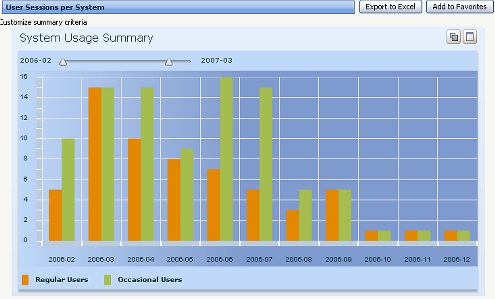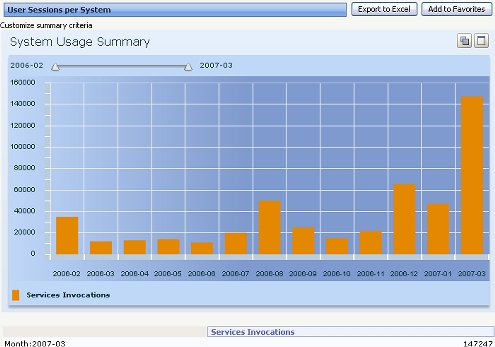
 Usage Metrics Reports and charts
Usage Metrics Reports and charts
 Usage Metrics Reports and charts
Usage Metrics Reports and chartsThe License Compliance facility provides a flexible framework for collecting usage data that in summary can provide evidence about past usage of a Process Commander system. This data can assess compliance with Pegasystems software license terms. PROJ-574 For basic information about this facility, see Working with the License Compliance facility.
From the![]() > System >Tools menu of the Designer Studio, you can access
three standard charts and a report to summarize past usage data that is
recorded as instances of the Log-License-Usage-Summary
class.
> System >Tools menu of the Designer Studio, you can access
three standard charts and a report to summarize past usage data that is
recorded as instances of the Log-License-Usage-Summary
class.
The definitions of such terms as regular user, occasional user, and service invocation may vary from system to system, depending on the Data-Admin-License data instance referenced in the License Parameters name field of the Production tab of the Data-Admin-System record. If the License Parameters name field is blank, default definitions apply.
Select ![]() > System >Tools > Usage Metrics > Usage Summary
Reports to view a summary view report presenting to-date usage data
on your system. PROJ-532 and Rule-523 MELLJ This report has the
following columns:
> System >Tools > Usage Metrics > Usage Summary
Reports to view a summary view report presenting to-date usage data
on your system. PROJ-532 and Rule-523 MELLJ This report has the
following columns:
Select ![]() > System >Tools > Usage Metrics > Named Users Chart to
view an interactive column chart showing the counts of regular users and
named users by period. Data appears below the chart.
> System >Tools > Usage Metrics > Named Users Chart to
view an interactive column chart showing the counts of regular users and
named users by period. Data appears below the chart.

The standard summary view rule is Log-License-Usage-Summary.StandardNamedUsers.ALL.
Select ![]() > System >Tools > Usage Metrics > Services Invocation
Chart to view an interactive column chart showing the count of
service invocations by period. Data appears below the chart.
> System >Tools > Usage Metrics > Services Invocation
Chart to view an interactive column chart showing the count of
service invocations by period. Data appears below the chart.

This chart is produced by the standard summary view rule named Log-License-Usage-Summary.StandardServicesInvocations.ALL.
Select ![]() > System >Tools > Usage Metrics > Web Invocations Chart to view an
interactive column chart showing the count of external assignments by
period. Data appears below the chart.
> System >Tools > Usage Metrics > Web Invocations Chart to view an
interactive column chart showing the count of external assignments by
period. Data appears below the chart.

The standard summary view rule is Log-License-Usage-Summary.StandardWebInvocations.ALL.

|
interactive chart, occasional user, regular user, service invocation |

|
About License Compliance data instances |